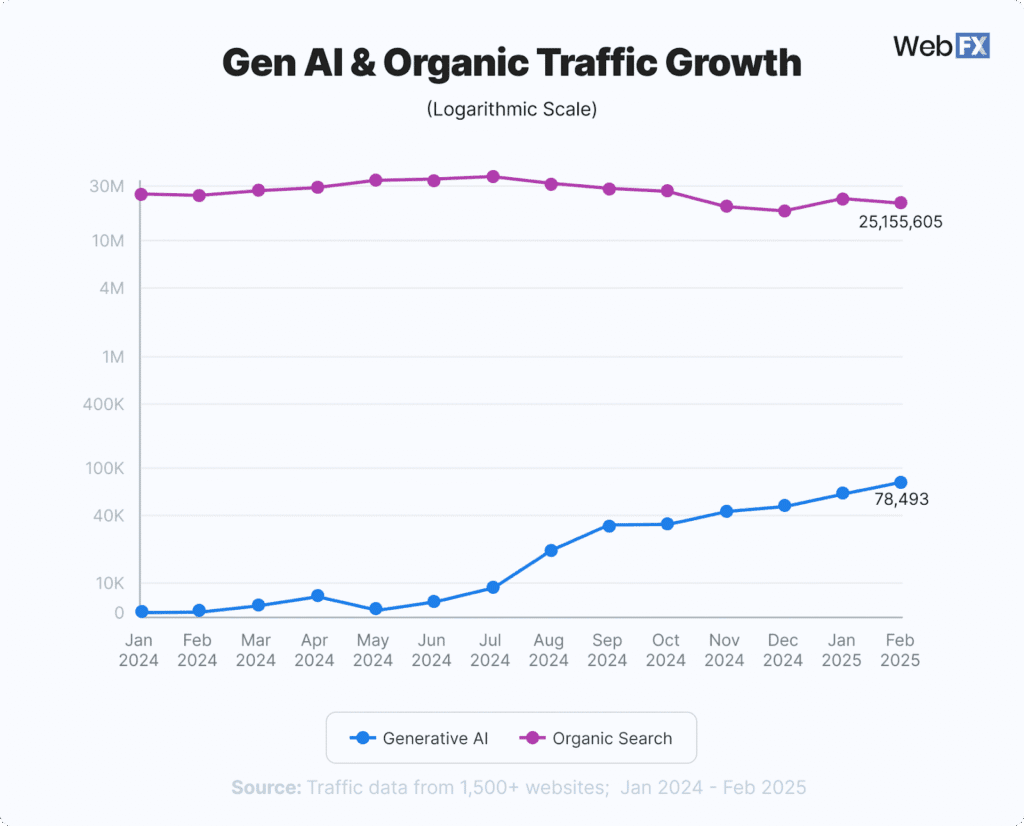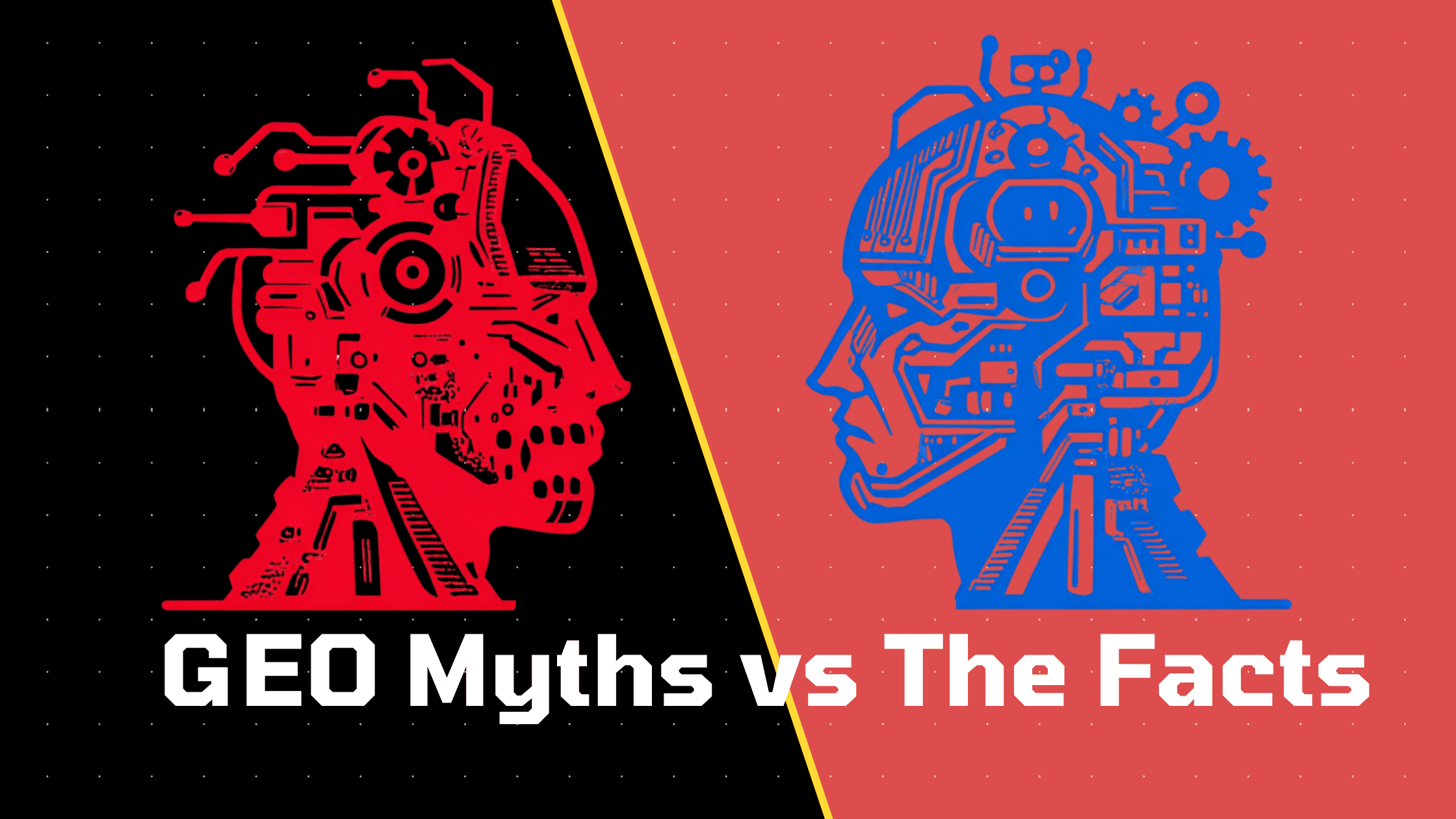Table of contents
TL;DR
- GEO doesn’t replace SEO; it reorients your goal from rankings to citations in AI answers.
- LLMs favor clear entities, citable snippets, and credible sources across multiple surfaces, not just your website.
- Measure GEO by tracking brand mentions in AI answers, referral traffic from AI surfaces, and conversion impact, not positions.
- Pilot GEO on a revenue-critical topic, structure for citations, and build authority on and off your site.
What Is GEO and Why the Myths Now?
Generative Engine Optimization ensures your brand is recognized by large language models (LLMs) like ChatGPT, Perplexity, Claude, or Google’s AI Overviews. It involves structuring your content so LLMs can easily find, understand, and cite it.
But simple as it may sound conceptually, myths and confusion are spreading. Large language models are constantly changing, producing different outputs for the same input, and don’t rely on traditional rankings. That’s why founders hear exaggerated claims like “SEO is dead,” “links don’t matter,” or “AI will replace everything.” The truth is simpler: GEO complements SEO and rewards the basics: clear entities, expert sources, and well-structured content. Understanding how GEO differs from SEO and AEO helps founders separate fact from fiction and focus on strategies that genuinely improve visibility in both traditional search and AI-driven responses.
Understanding SEO, GEO and AEO
Search Engine Optimization (SEO), Generative Engine Optimization (GEO), and Answer Engine Optimization (AEO) share a common goal, visibility, but each takes a different path.
- SEO improves rankings in traditional search results by optimizing content, links, and technical elements so search engines understand and rank your pages. The result is higher visibility on search engine results pages (SERPs), typically driving organic traffic.
- GEO positions your brand for inclusion in AI-generated responses by structuring content so large language models can find, interpret, and cite it. The outcome is increased brand presence in AI-driven answers, influencing how your content appears when users ask LLMs like ChatGPT or Claude.
- AEO targets direct answers in formats like featured snippets, FAQs, and other concise answer boxes. By crafting highly focused, structured, and authoritative content, you increase the chance your answer is selected for immediate display, providing quick visibility and establishing trust with users.
Succeeding in this new environment requires more than keywords. Generative engines and large language models prefer content that’s easy to extract and cite, which means structuring information into clear definitions, step-by-step explanations, comparisons, or checklists, all backed by credible sources. At the same time, strong signals, like unambiguous entity references, descriptive schema, and expert authorship, help models validate your authority. The principles of E-E-A-T (Expertise, Experience, Authoritativeness, Trustworthiness) still apply, and a well-organized content ecosystem with pillar pages, supporting articles, documentation, and case studies increases your chances of being chosen when AI systems compile responses.
Knowing how SEO, GEO, and AEO differ sets the foundation, but to leverage them effectively, you also need to understand how large language models analyze and extract information from your content.
How LLMs “Read” Your Content
Language models don’t read like humans, they process content in chunks. That’s why clear structure matter, so to make sure your content gets picked up, present it in a way that’s easy to scan and digest. Break things down with clear headings, short paragraphs, bullet points, and even FAQs. Each section should answer one question or explain one concept. This not only improves retrieval but also increases the chances of your content being cited.
Equally crucial as structure is how you present information. Maintaining a neutral, accurate tone, especially in educational content, makes your work more trustworthy. Models tend to favor content that’s balanced, well-researched, and backed by credible sources. Linking to original studies or authoritative references further strengthens that credibility. And when two pieces cover the same topic, the unbiased, well-cited version is the one most likely to be chosen. That’s why it pays to set aside the sales pitch here and focus on clarity and authority instead.
Finally, credibility comes from depth and consistency. Build comprehensive main pages, support them with related articles, and use internal links to show how everything connects. This not only helps search engines but also signals to generative models that your site is a reliable, well-organized source. By combining clear structure, impartiality, and thorough coverage, you position your content as a trusted reference for a wide range of queries.
Even with clear explanations of how LLMs read content, many people still misunderstand GEO. These misunderstandings have led to common myths.
GEO Myths, Debunked
Myth 1: “GEO replaces SEO”

LinkedIn post claiming “SEO is dead,” illustrating the myth that GEO replaces SEO.
Source: LinkedIn
Fact: GEO doesn’t replace SEO but rather shifts optimization focus in complementary ways. While SEO builds the essential technical foundation through site crawlability and demand capture, GEO enhances this foundation by implementing structured formatting and clear sourcing that LLMs can easily cite.
This relationship works because your strongest SEO pages, those with established authority, valuable backlinks, and comprehensive content, naturally become your most effective GEO resources.
The connection is straightforward: LLMs typically gather citations through search engines, so strong SEO positioning ensures your content appears in retrieval sets, creating the necessary foundation for GEO success. Currently, GEO drives only a small portion of search traffic compared to traditional SEO, SERPs, and branded searches, making it an important additional channel rather than a replacement strategy, as stated by Search Engine Land.

Source: WebFX
Action: Focus on maintaining a strong SEO foundation and gradually layer GEO practices on top, using your highest-performing SEO pages as the starting point to increase AI visibility.
Myth 2: “GEO is just hype”

X post calling GEO and related terms “just buzzwords,” showing how some people dismiss it as hype.
Source: X
Fact: While GEO currently represents only a small fraction of overall search, the conversion potential is high, and the usage growth of AI search tools is impossible to ignore.
Consider how Perplexity AI has more than tripled its monthly queries from 230 million in mid-2024 to over 780 million by May 2025. Similarly, ChatGPT now handles an impressive 2.5 billion daily prompts, connecting with more than 500 million active users every week across the globe. At the same time, Google’s AI Overviews have already established a massive reach of over 2 billion monthly users. Because these platforms either function primarily as search engines (like Perplexity) or have deeply integrated search capabilities (as with Google and ChatGPT), GEO’s relevance will naturally increase as user behavior shifts.
Action: : Don’t wait for GEO to become a larger share of search, start preparing now. Identify the parts of your customer journey where AI-generated answers are most likely to influence decisions, and prioritize those topics by optimizing your site This way, you capture today’s smaller but conversion-rich GEO traffic while positioning for tomorrow’s larger share.
Myth 3: “AI-written content is penalized, so GEO can’t use it”

X post claiming that Google penalizes AI content, reflecting the myth that GEO can’t use AI-generated material.
Source: X
Fact: Contrary to this myth, a study published in Proceedings of the National Academy of Sciences found that, in some cases, LLMs showed a higher preference for AI-generated texts compared to human-written ones. Models are not concerned with how your first draft was written; their focus is on whether the final page is accurate, useful, and trustworthy. So, maintaining quality, accuracy, and usefulness remains essential, and human oversight ensures AI-generated content meets editorial standards while performing well on both Google and LLMs.
Action: Use AI to accelerate drafting, but don’t skip human oversight. Edit carefully, cite sources, and showcase E-E-A-T signals. Publish under expert bylines, add reviewer notes, and include credentials and update dates to strengthen credibility.
Myth 4: “GEO is just adding schema and FAQs”

X post explaining that GEO involves structured data and FAQs, but also additional elements beyond that.
Source: X
Fact: While schema and FAQs help search engines understand and present content, they alone aren’t enough to establish authority. GEO requires depth and consistency across a cluster of related topics, ensuring your brand is recognized as a credible and comprehensive source within its niche. According to a guide by MarketMuse, correctly implemented topic clusters can significantly impact SEO results by building topical authority and increasing website authority and overall page ranking.
Additionally, a recent experiment discussed by Dejan tested whether OpenAI’s browsing tool could supply GPT-5 with grounding context from pages containing schema. The results showed that the AI model only used visible text content, ignoring structured data and metadata. This shows that while schema can enhance search snippets, it isn’t automatically leveraged by AI models and cannot replace comprehensive topical authority in GEO.
Action: Combine schema with in-depth pillar pages, expert authorship, and cross-platform authority, including documentation, reviews, and forums. Support your claims with credible sources like documentation, GitHub repositories, G2/Capterra reviews, and community insights. These signals extend beyond just your website and are recognized by models.
Myth 5: “Optimizing your website is enough”

A post emphasizing that website optimization alone is not enough,GEO requires going beyond traditional SEO into AI-driven visibility
Source: X
Fact: Generative AI doesn’t just crawl your website, it gathers information from across the digital landscape, including community forums, technical documentation, customer reviews, downloadable resources, and more. According to Decodo, AI systems train on data from a wide range of online content to generate accurate and helpful responses. So, a limited presence beyond your own site can severely restrict your visibility to both AI models and potential customers.
Action: Create a strategic footprint across multiple platforms: comprehensive guides on your website, technical documentation on GitHub, thought leadership articles on LinkedIn, and active participation in industry forums where your expertise shines through.
Myth 6: “High-volume keywords are the GEO play”

Reddit comment highlighting that success in GEO isn’t about high-volume keywords, but about clear, helpful content and being present where AI looks.
Source: Reddit
Fact: Chasing high-volume keywords like “CRM software” fundamentally misses how people interact with AI in practice. Instead of these broad terms, people create longer, more detailed queries that expose their specific needs. Phrases such as; “How do I automate lead scoring in Salesforce” or “What’s the best email marketing platform for SaaS startups.” This evolution is significant because large language models thrive on processing these detailed prompts.
The additional context allows AI to highlight particular products, draw subtle distinctions between options, and tackle specific user challenges rather than merely matching generic search terms. Recent data from BrightEdge confirms this trend: lengthy, conversational queries have surged dramatically, with searches containing 8+ words that trigger AI Overviews increasing sevenfold since May 2024..
Action: Prioritize content that addresses complete workflows (“How do I integrate Slack with my customer support dashboard?”), product evaluations (“Best analytics tool for tracking SaaS customer churn”), and direct comparisons (“HubSpot vs. Intercom for SaaS customer messaging”). By creating structured content around these real-world problems and decisions, you’ll capture the queries that actually drive conversions.
Myth 7: “Once cited, always cited”

Source: X
Fact: Inclusion in AI responses is not permanent; it’s an ever-evolving process. Your content’s visibility can be affected by several factors, such as model updates, emerging sources, and users rephrasing their prompts. As a result, even if your content is visible today, it doesn’t guarantee it will stay that way indefinitely.
Static content tends to lose visibility over time, so to maintain a presence in AI-driven answers, you need to consistently publish fresh material and continuously build authority in your field. According to Seer Interactive, nearly 65% of AI bot hits target content published in just the past year, highlighting the importance of content recency in AI visibility.
Action: Keep your content current by regularly refreshing it with new data, updated screenshots, and expanded FAQs. Build deeper expertise across related topics, and consistently check whether various prompts still surface your content in responses.
Myth 8: “You can’t measure GEO”

Reddit comment arguing that GEO is hard to measure, linked to the common myth that it can’t be tracked.
Source: Reddit
Fact: While traditional SEO rankings don’t apply, you can still measure what truly matters: your visibility, referrals, and revenue impact. Instead of tracking page positions, focus on how often your brand appears in AI-generated answers, how much traffic these mentions drive to your site, and most importantly, how many conversions they generate. This approach ensures you’re capturing the real value of Generative Engine Optimization rather than relying on outdated metrics.
Action: Combine strategic prompt testing with proper analytics tagging and CRM attribution. This creates a clear picture of your true performance. Start by building a simple GEO dashboard that tracks three key metrics: 1- How frequently your content appears across different AI engines; 2- The quality of these mentions (are you getting named links or just passing references?); 3- The actual business impact through properly tagged AI referral traffic and resulting conversions. You can learn more about how to measure the success of GEO campaigns here.
A Practical, ROI-Oriented GEO Playbook
With the misconceptions out of the way, here’s a practical playbook to make GEO work in the real world.
- Pick a high-revenue topic – Start with a subject that directly impacts your bottom line, such as a high-intent workflow your users search for, a detailed category comparison, or a competitor alternative. Focus on topics that drive real conversions.
- Build a pillar-and-cluster structure – Create one comprehensive hub page as the central resource, supported by 4–6 articles that dive into specific questions or subtopics in a PAA-style format. This structure shows AI the depth and breadth of your expertise and helps organize content for better citation.
- Optimize for AI citations – Make your content easy for AI to understand and reference. Include clear definitions upfront, TL;DR summaries, checklists, highlighted comparisons, FAQs, and source citations. Add update stamps to signal freshness, as AI models prioritize current, accurate content.
- Expand your reach – Distribute content beyond your website. Share condensed versions on LinkedIn, post technical insights on GitHub or in product documentation, and aim for mentions in 2–3 trusted third-party lists or reviews. A multi-platform presence signals authority and increases AI visibility.
- Track performance – Measure what matters. Set up 25–50 prompts across AI engines to monitor inclusion rates monthly. Use UTMs to track AI-driven traffic and attribute assisted conversions in your CRM. This shows the real business impact of GEO efforts.
- Iterate quarterly – GEO requires ongoing attention. Refresh content with updated data, new examples, and insights. Explore related topics such as integrations, use cases, or industry-specific content to maintain authority and broaden AI recognition. Regular updates help keep your content visible and relevant.
Bottom Line: A Practical Path to GEO Advantage
Generative Engine Optimization (GEO) is an evolution of digital visibility, not a replacement for SEO. The key to success lies in clarity, credibility, and usefulness: clearly define your entities, structure your content for citation, and maintain consistent, authoritative sourcing. These fundamentals increase the chances that large language models (LLMs) like ChatGPT or Claude will discover and reference your content.
The implication is that GEO requires a thoughtful, measured approach. It’s not just about creating content but building structured clusters, monitoring AI inclusion, and iterating based on real performance. By focusing on measurable impact, you ensure your efforts drive visibility, traffic, and conversions, rather than just producing isolated pages.


